Did you know over 70% of adults in the United States don’t eat enough fruits and veggies? This fact shows we really need to know what a balanced diet is and how to get it. This guide will cover the basics of healthy eating. It will help you make choices that are good for your body and overall health.
Key Takeaways
- A balanced diet includes a variety of foods from all the main groups.
- Knowing about macronutrients (like proteins and fats) and micronutrients (like vitamins) is key for health.
- Controlling portions and calories is important for a balanced diet and a healthy weight.
- Planning meals that last and avoiding common diet mistakes are crucial for long-term success.
- It’s possible to adapt a balanced diet to fit special dietary needs with the right strategies.
Understanding the Foundations of a Balanced Diet
Nutrition is key to a healthy life. Knowing what makes up a balanced diet is important. It gives our bodies the nutrients they need and helps prevent health problems.
Key Components of Healthy Eating
A balanced diet includes many types of foods. These are:
- Fruits and vegetables
- Whole grains
- Lean proteins
- Healthy fats
- Dairy or dairy alternatives
The Science Behind Nutritional Balance
Nutrition science is complex. It involves macronutrients like proteins, carbs, and fats. And micronutrients like vitamins and minerals. These work together to keep our bodies running well.
Benefits of Proper Nutrition
Eating right has many benefits. Some are:
- More energy and clear thinking
- A stronger immune system and lower disease risk
- Helps manage weight and avoid obesity
- Stronger bones and teeth
- Better skin, hair, and nails
Learning about balanced diets helps us make better food choices. This improves our health and well-being.
“Proper nutrition is not just about looking good, but about feeling your best and living a long, healthy life.”
Essential Food Groups for Optimal Health
Keeping a balanced diet is key for good health. At the core of a healthy diet are the essential food groups. They give us the nutrients we need. Let’s look at the main food groups for a balanced diet.
Fruits and Vegetables
Fruits and vegetables are packed with vitamins, minerals, and fiber. They have antioxidants that boost our immune system and fight off diseases. Try to eat a variety of colorful fruits and veggies every day.
Whole Grains
Whole grains like whole wheat, brown rice, and quinoa are full of complex carbs, fiber, and B vitamins. They give us lasting energy and help with digestion. Choose whole-grain options over refined grains for better nutrition.
Lean Proteins
Lean proteins, like chicken, fish, beans, and eggs, help build and fix body tissues. They also keep us full. Mix different lean proteins in your meals for a good mix of amino acids.
Dairy or Dairy Alternatives
Dairy products, like milk, yogurt, and cheese, are great for calcium. This is important for strong bones and teeth. If you can’t have dairy, try almond, soy, or oat milk for similar benefits.
By choosing a variety of foods from these groups, you can create a balanced diet. This supports your health and well-being.
| Food Group | Key Nutrients | Health Benefits |
|---|---|---|
| Fruits and Vegetables | Vitamins, minerals, fiber, antioxidants | Immune support, disease prevention, digestive health |
| Whole Grains | Complex carbohydrates, fiber, B vitamins | Sustained energy, improved digestion |
| Lean Proteins | Amino acids, minerals | Tissue repair and maintenance, satiety |
| Dairy or Dairy Alternatives | Calcium, vitamin D | Bone and teeth health |
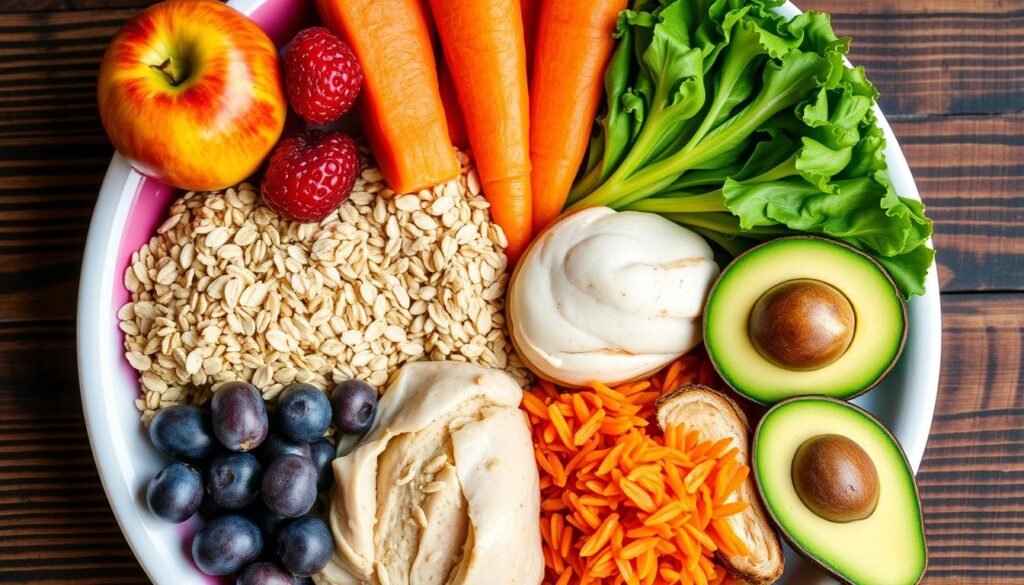
“A balanced diet is not about deprivation, but rather about finding the right combination of nutrient-dense foods to nourish your body and mind.”
Macronutrients: Your Body’s Primary Fuel Sources
Keeping a balanced diet is key for good health. Knowing about macronutrients is important. These are proteins, carbohydrates, and fats. They give our bodies the energy and parts needed to work well.
Proteins: Building Blocks of Life
Proteins are the basic parts of our cells, tissues, and organs. They help fix and keep our body parts in shape. They also boost our immune system. Good protein sources are lean meats, fish, eggs, beans, and dairy.
Eating a variety of these foods helps meet your protein needs. This supports your nutrition and healthy eating.
Carbohydrates: Energy Providers
Carbohydrates give our bodies energy. They turn into glucose, which powers our cells. This energy is for our physical and mental work.
Good carbs come from whole grains, fruits, veggies, and beans. These provide lasting energy and important macronutrients. Choosing these carbs helps your healthy eating plan.
Healthy Fats: Essential for Function
Not all fats are bad. Healthy fats, like those in avocados, nuts, seeds, and fatty fish, are vital. They help make hormones, absorb nutrients, and support brain function.
These macronutrients also make you feel full longer. This helps your nutrition and healthy eating goals.
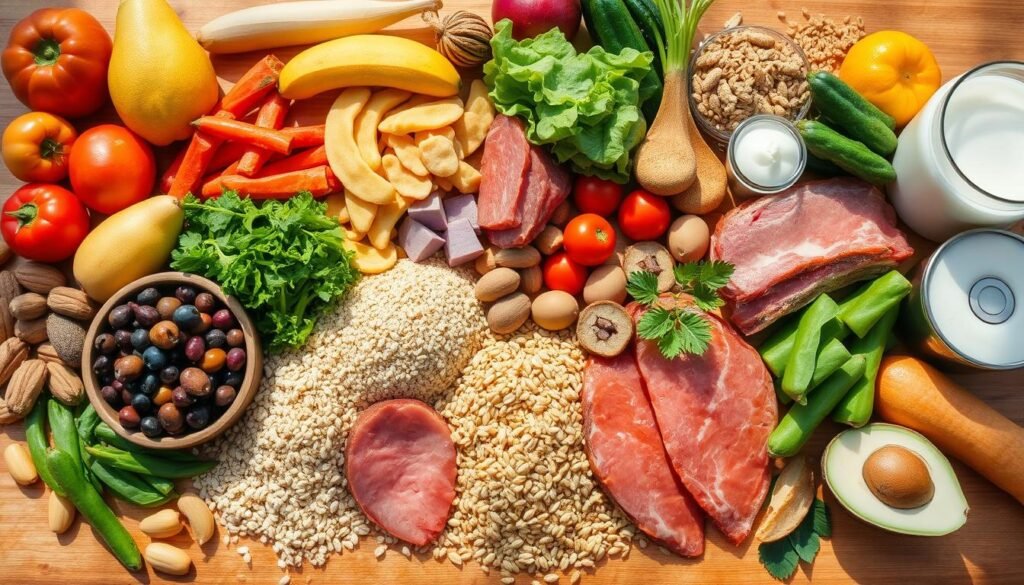
“A balanced diet rich in macronutrients is the foundation for optimal health and vitality.”
Micronutrients: Vitamins and Minerals You Need
Micronutrients are key to a balanced diet, but often get overlooked. They are vital for health and well-being. These nutrients help boost the immune system and support energy production.
A wide range of micronutrients is crucial. This includes vitamins A, C, D, E, and the B-complex, along with minerals like iron, calcium, magnesium, and zinc. Each micronutrient has a unique role in the body’s functioning.
Vitamin A is important for vision, skin, and immune health. Vitamin C acts as an antioxidant, protecting cells and aiding collagen production. Calcium and vitamin D are essential for strong bones and teeth. B-vitamins are vital for energy and nerve function.
Eating a variety of nutrient-rich foods is key. Include fruits, vegetables, whole grains, lean proteins, and dairy in your diet. For those with dietary needs, supplements can help. But, aim for a balanced diet with a wide range of micronutrients.
| Micronutrient | Key Functions | Food Sources |
|---|---|---|
| Vitamin A | Vision, immune function, skin health | Carrots, sweet potatoes, leafy greens, dairy products |
| Vitamin C | Antioxidant, collagen production, immune support | Citrus fruits, bell peppers, strawberries, broccoli |
| Calcium | Bone and tooth health, muscle function | Dairy products, leafy greens, fortified foods |
| Iron | Oxygen transport, energy production, immune function | Red meat, poultry, lentils, spinach |
By eating a variety of micronutrient-rich foods, you support your body’s needs. Focus on your nutrition and make smart choices for better health and well-being.
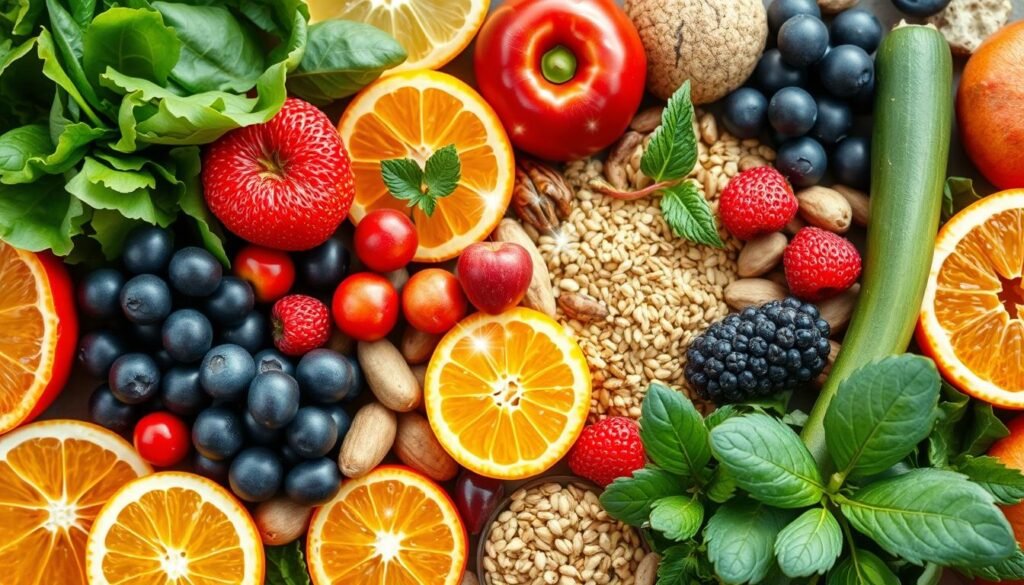
Portion Control and Calorie Management
Keeping a balanced diet is more than picking the right foods. It’s also about controlling portions and managing calories. Knowing serving sizes and balancing calorie counting with listening to your body helps you make smart food choices.
Understanding Serving Sizes
It’s easy to eat too much without realizing it. Learning what a standard serving size is for each food group is key. Using measuring tools and visual guides can help you know how much to eat.
Calorie Counting vs. Intuitive Eating
Calorie counting can be helpful but can feel too strict for some. Intuitive eating, on the other hand, focuses on listening to your body’s hunger and fullness signals. Finding a mix of both can be the best approach for you.
Tools for Portion Management
- Investing in a food scale to weigh portions accurately
- Using smaller plates and bowls to create the illusion of a fuller plate
- Practicing mindful eating by savoring each bite and paying attention to hunger and satiety signals
- Incorporating pre-portioned snacks or meal-prep containers into your routine
By understanding portion sizes, balancing calorie counting with intuitive eating, and using helpful tools, you can manage your calorie intake and portion control. This supports your healthy eating journey.
| Food Item | Standard Serving Size | Calorie Content |
|---|---|---|
| Pasta | 1/2 cup cooked | 200 calories |
| Chicken Breast | 3-4 oz cooked | 150 calories |
| Broccoli | 1 cup raw | 30 calories |
| Almonds | 1/4 cup | 160 calories |
Creating a Sustainable Meal Plan
Making a sustainable meal plan is key for a balanced diet and healthy eating. It helps your body get the nutrients it needs. It also makes your daily routine easier and cuts down on food waste.
First, figure out what nutrients you need based on your age, how active you are, and any special diets. This tells you how much of each nutrient your meals should have.
Key Steps for Meal Planning
- Meal Prep: Set aside time each week to prep meal parts, like chopping veggies or cooking grains. This makes cooking faster and keeps healthy food ready.
- Balanced Plate: Aim for a balanced plate with different food groups. Include fruits, veggies, whole grains, lean proteins, and healthy fats.
- Adaptability: Be open to changing your meal plan as needed. Mix quick meals with more complex ones to keep things interesting.
By following these steps, you can make a sustainable meal plan that boosts your health. It also makes healthy eating easier and more fun.
“The key to a balanced diet is not deprivation, but rather finding the right combination of nutritious and satisfying foods that you genuinely enjoy.” – Nutritionist Jane Doe

Common Mistakes to Avoid When Following a Balanced Diet
Keeping a balanced diet is key for good health. But, many people make mistakes that slow them down. Let’s look at some common errors to avoid when trying to eat better.
Overcoming Diet Pitfalls
One big mistake is being too strict with food. It’s good to watch what you eat, but cutting out too much can be bad. Try to eat a variety of foods to get all the nutrients your body needs.
Myths and Misconceptions
Many people believe in diet myths. For example, some think certain foods can magically make them healthy. Or that cutting carbs is the only way to lose weight. These ideas can make you stressed and unhealthy. Always check facts and talk to nutrition experts for the best advice.
Making Lasting Changes
Changing your eating habits for good can be hard. Quick diets often don’t work and you might gain back weight. Try making small, lasting changes. This could mean eating more veggies, watching your portions, or finding fun ways to move.
By avoiding these mistakes, you can start a journey to a balanced diet. This will help you stay healthy and feel good.
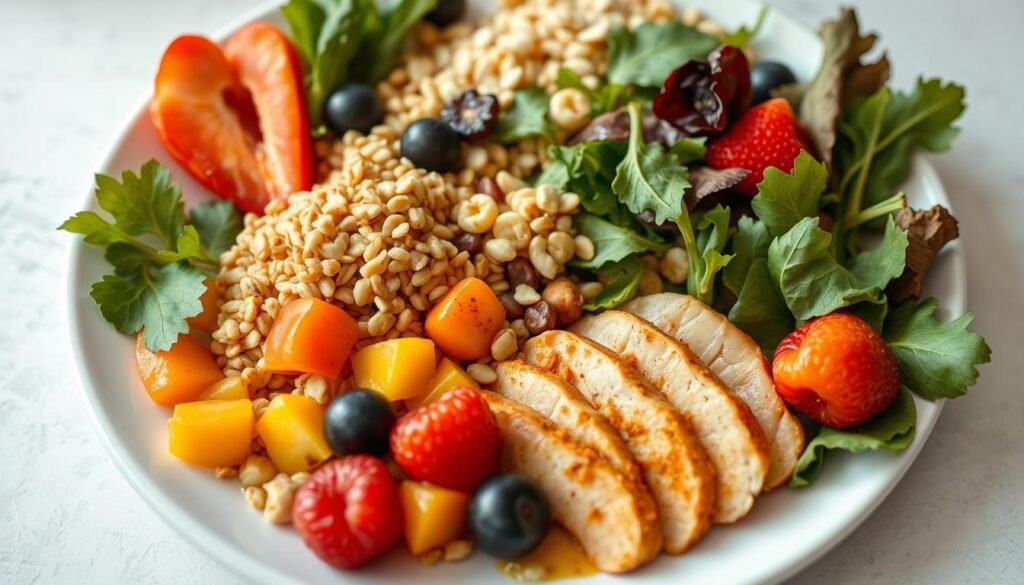
Tips for Maintaining a Balanced Diet on a Budget
Eating well doesn’t have to cost a lot. With smart strategies, you can enjoy healthy meals without spending too much. Here are some tips to help you eat healthy on a budget:
- Plan Your Meals – Take time to plan your meals and make a shopping list. This helps you buy only what you need, cutting down on waste and impulse buys.
- Embrace Seasonal Produce – Produce in season is often cheaper and fresher. Use local markets or sales to get seasonal fruits and veggies.
- Buy in Bulk – Buying non-perishable items like grains and spices in bulk saves money. Look for sales to stock up on these items.
- Opt for Frozen Foods – Frozen foods like fruits, veggies, and proteins are just as good as fresh ones but cheaper. Keep your freezer full of these options.
- Meal Prep and Batch Cook – Spend a few hours on the weekend meal prepping and batch cooking. This saves time and money during the week, keeping you from expensive takeout.
Using these budget-friendly tips, you can eat well without hurting your wallet. A little planning and creativity can help you stay healthy on a tight budget.
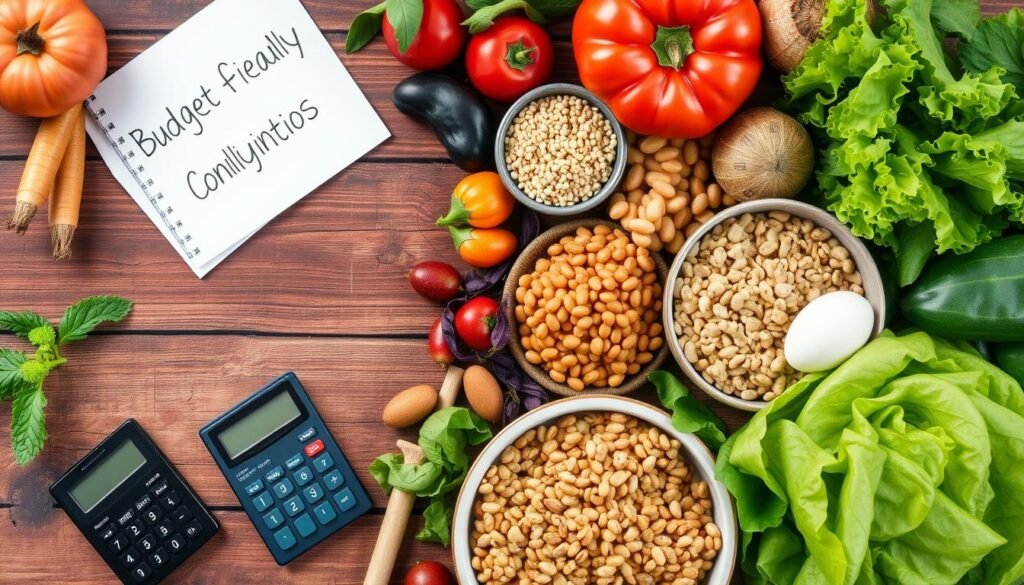
“Eating well on a budget is all about being smart, strategic, and creative with your food choices.”
Adapting a Balanced Diet to Special Dietary Needs
Keeping a balanced diet is key for good health. But, people with special diets like vegetarians, vegans, or those with food allergies face challenges. This part will show how to adjust a balanced diet for different needs while getting enough nutrients.
Vegetarian and Vegan Diets
Vegetarians and vegans might worry about getting enough protein, iron, and vitamin B12. It’s crucial to eat a variety of plant-based proteins like beans, lentils, tofu, and nuts. Also, using fortified foods or supplements can help meet these needs.
Gluten-Free Diets
People with gluten intolerance or celiac disease must avoid gluten. A balanced diet for them might include gluten-free grains like quinoa, rice, and gluten-free oats. They should also eat more fruits, vegetables, and lean proteins.
Allergen-Free Diets
Those with food allergies need to avoid certain foods. To adapt a balanced diet, they can use allergen-free products and eat a wide variety of foods. This ensures they get all the nutrients they need.
Getting help from a healthcare professional or a registered dietitian is vital. They can help plan meals, ensure nutrient intake, and suggest supplements if needed. This ensures a balanced diet that supports overall health.
| Dietary Requirement | Nutrient Considerations | Recommended Substitutions |
|---|---|---|
| Vegetarian/Vegan | Protein, Iron, Vitamin B12 | Beans, Lentils, Tofu, Fortified Foods |
| Gluten-Free | Gluten-Containing Grains | Quinoa, Rice, Gluten-Free Oats |
| Allergen-Free | Trigger Foods | Allergen-Free Alternatives |
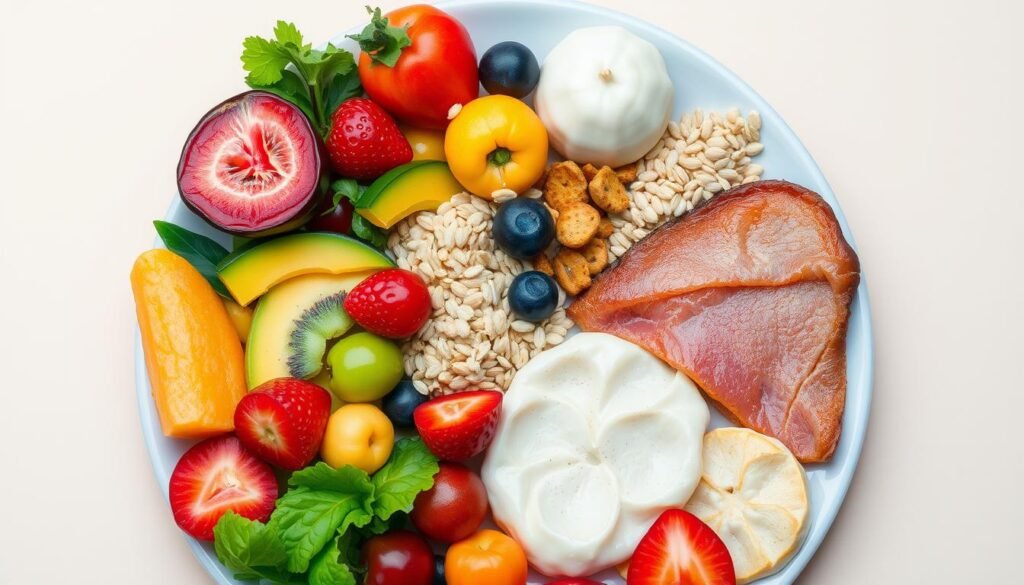
“Adapting a balanced diet to meet individual dietary needs requires creativity, dedication, and a willingness to explore new food options. With the right guidance, it’s possible to maintain a healthy, nutritious lifestyle while accommodating specific dietary requirements.”
The Role of Hydration in a Balanced Diet
Drinking enough water is key to a balanced diet and staying healthy. Water helps keep our body’s nutrition in check and supports many body functions.
The amount of water we need daily depends on our age, gender, and how active we are. But, most people should aim for at least 11.5 cups (2.7 liters) of water a day.
- Staying hydrated helps control body temperature, aids digestion, and boosts brain function.
- It also helps with weight control by preventing overeating and keeping you feeling full.
- Water is vital for moving nutrients, getting rid of waste, and keeping our skin healthy.
To make sure you’re drinking enough hydration, try these tips:
- Always carry a refillable water bottle and drink from it all day.
- Eat more foods with lots of water, like fruits and veggies.
- Avoid drinks with sugar or caffeine, as they can dry you out.
- Drink water before meals to help with digestion and avoid eating too much.
| Beverage | Hydration Level |
|---|---|
| Water | Optimal |
| Herbal Tea | Hydrating |
| Juice | Moderately Hydrating |
| Soda | Dehydrating |
| Alcohol | Dehydrating |
By focusing on hydration and adding water-rich foods and drinks to your balanced diet, you’ll support your health and well-being.
“Drinking water is the single most important thing you can do for your health.”- Sebastian Lletget, professional soccer player
Conclusion
Maintaining a balanced diet is key for your health and happiness. Understanding healthy eating and managing nutrients helps you make better food choices. This empowers you to take care of your nutrition.
We’ve looked at the science of nutrition and its benefits. We’ve also shared ways to create a lasting meal plan. Plus, we’ve talked about avoiding diet mistakes and staying hydrated.
A balanced diet and exercise can greatly improve your life. By following healthy eating and nutrition principles, you can achieve your best health. This unlocks your body and mind’s full potential.
FAQ
What are the key components of a balanced diet?
A balanced diet includes a variety of foods from different groups. This includes fruits, vegetables, whole grains, lean proteins, and dairy. It’s also important to get the right mix of macronutrients and micronutrients.
Why is it important to maintain a balanced diet?
Eating a balanced diet gives your body the nutrients it needs. It helps keep you healthy, supports your immune system, and lowers the risk of diseases. It also boosts your overall well-being.
How do I know if I’m getting the right amount of macronutrients?
The amount of macronutrients you need depends on your age, gender, and how active you are. Aim for 45-65% of your calories to come from carbs, 10-35% from proteins, and 20-35% from fats.
What are the most important micronutrients to include in my diet?
Focus on vitamins A, C, D, and E, and minerals like iron, calcium, and magnesium. Eating a variety of fruits, vegetables, whole grains, and lean proteins helps you get these nutrients.
How can I control my portion sizes?
Controlling portion sizes is key to a balanced diet. Use your hand or a measuring cup to gauge serving sizes. Try eating off smaller plates and listen to your body’s hunger and fullness signals.
What are some common mistakes to avoid when following a balanced diet?
Don’t over-restrict certain foods, rely too much on supplements, or follow every diet fad. Plan your meals and make sustainable changes. Avoid extreme diets that are hard to stick to.
How can I create a balanced meal plan on a budget?
To eat well on a budget, buy in-season produce and buy in bulk. Use more plant-based proteins like beans and lentils. Meal prep and plan ahead to save money and get the nutrients you need.
How do I adapt a balanced diet to accommodate special dietary needs?
Adapting to special diets like vegetarian, vegan, or gluten-free requires planning. Make sure you’re getting all the nutrients you need by focusing on nutrient-dense foods. If needed, use supplements.
How much water should I be drinking as part of a balanced diet?
The amount of water you should drink varies based on your age, gender, and activity level. Aim for at least 11.5 cups (2.7 liters) for women and 15.5 cups (3.7 liters) for men. Drinking enough water is crucial for a balanced diet.

Hello, I’m Jimmy, founder of Jimmy Cozy Life. I’m here to help you create a home that feels warm, stylish, and balanced. With ideas for decor, celebrations, wellness, and DIY projects, my goal is to share practical tips and a bit of inspiration to make your space truly special.
Disclosure: This post contains affiliate links. If you click and make a purchase, we may receive a small commission at no extra cost to you. The content on this website was developed with assistance from AI.



